Toxicological and biochemical basis of synergism between the entomopathogenic fungus Lecanicillium muscarium and the insecticide matrine against Bemisia tabaci (Gennadius)
- PMID: 28425450
- PMCID: PMC5397844
- DOI: 10.1038/srep46558
Toxicological and biochemical basis of synergism between the entomopathogenic fungus Lecanicillium muscarium and the insecticide matrine against Bemisia tabaci (Gennadius)
Abstract
The sweetpotato whitefly Bemisia tabaci (Gennadius) was challenged with different combinations of matrine (insecticide) and Lecanicillium muscarium (entomopathogenic fungus). Our results revealed a synergistic relationship between matrine and L. muscarium on mortality and enzyme activities of B. tabaci. To illustrate the biochemical mechanisms involved in detoxification and immune responses of B. tabaci against both control agents, activities of different detoxifying and antioxidant enzymes were quantified. After combined application of matrine and L. muscarium, activities of carboxylestrease (CarE), glutathione-s-transferase (GSTs) and chitinase (CHI) decreased during the initial infection period. Acetylcholinestrase (AChE) activities increased during the entire experimental period, whereas those of superoxide dismutase (SOD), peroxidase (POD) and catalase (CAT) decreased during the later infection period. The increased mortality and suppression of enzymatic response of B. tabaci following matrine and L. muscarium application suggests a strong synergistic effect between both agents. The strong synergistic effect is possibly related to the disturbance of acetylcholine balance and changes in AchE activities of the whitefly as both matrine and L. muscarium target insect acetylcholine (Ach) receptors which in turn effects AchE production. Therefore, our results have revealed the complex biochemical processes involved in the synergistic action of matrine and L. muscarium against B. tabaci.
Conflict of interest statement
The authors declare no competing financial interests.
Figures

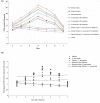
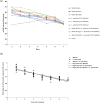
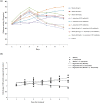
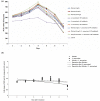
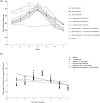
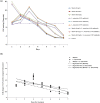
Similar articles
-
Compatibility of the entomopathogenic fungus Lecanicillium muscarium and insecticides for eradication of sweetpotato whitefly, Bemisia tabaci.Mycopathologia. 2005 Aug;160(1):35-41. doi: 10.1007/s11046-005-6835-4. Mycopathologia. 2005. PMID: 16160767
-
Pathogenicity of the entomopathogenic fungus, Lecanicillium muscarium, against the sweetpotato whitefly Bemisia tabaci under laboratory and glasshouse conditions.Mycopathologia. 2005 Nov;160(4):315-9. doi: 10.1007/s11046-005-0122-2. Mycopathologia. 2005. PMID: 16244900
-
The susceptibility of immature stages of Bemisia tabaci to the entomopathogenic fungus Lecanicillium muscarium on tomato and verbena foliage.Mycopathologia. 2005 Jan;159(1):23-9. doi: 10.1007/s11046-004-3127-3. Mycopathologia. 2005. PMID: 15750729
-
Update on the Status of Bemisia tabaci in the UK and the Use of Entomopathogenic Fungi within Eradication Programmes.Insects. 2013 May 16;4(2):198-205. doi: 10.3390/insects4020198. Insects. 2013. PMID: 26464385 Free PMC article. Review.
-
Insecticide resistance in Bemisia tabaci Gennadius (Homoptera: Aleyrodidae) and Anopheles gambiae Giles (Diptera: Culicidae) could compromise the sustainability of malaria vector control strategies in West Africa.Acta Trop. 2013 Oct;128(1):7-17. doi: 10.1016/j.actatropica.2013.06.004. Epub 2013 Jun 17. Acta Trop. 2013. PMID: 23792227 Review.
Cited by
-
Physiological and Molecular Response Modifications by Ultraviolet-C Radiation in Plutella xylostella and Its Compatibility with Cordyceps fumosorosea.Int J Mol Sci. 2022 Aug 29;23(17):9800. doi: 10.3390/ijms23179800. Int J Mol Sci. 2022. PMID: 36077199 Free PMC article.
-
In-vivo and in-vitro effectiveness of three insecticides types for eradication of the tick Rhipicephalus sanguineus in dogs.Open Vet J. 2022 Jan-Feb;12(1):44-60. doi: 10.5455/OVJ.2022.v12.i1.6. Epub 2022 Jan 19. Open Vet J. 2022. PMID: 35342737 Free PMC article.
-
Compatibility of synthetic and biological pesticides with a biocontrol agent Phytoseiulus longipes (Acari: Phytoseiidae).Exp Appl Acarol. 2024 Aug;93(2):273-295. doi: 10.1007/s10493-024-00926-3. Epub 2024 Jun 13. Exp Appl Acarol. 2024. PMID: 38869728 Free PMC article.
-
Matrine disturbs the eimeria necatrix-induced loop of tuft cell-intestinal stem cell-goblet cell by inactivating IL-13/JAK2/STAT3 signaling.Poult Sci. 2025 Feb;104(2):104786. doi: 10.1016/j.psj.2025.104786. Epub 2025 Jan 10. Poult Sci. 2025. PMID: 39798285 Free PMC article.
-
Comparative transcriptome analysis reveals differences in gene expression in whitefly following individual or combined applications of Akanthomyces attenuatus (Zare & Gams) and matrine.BMC Genomics. 2022 Dec 6;23(1):808. doi: 10.1186/s12864-022-09048-9. BMC Genomics. 2022. PMID: 36474158 Free PMC article.
References
-
- Barbosa L. D. et al.. Indigenous American species of the Bemisia tabaci complex are still widespread in the Americas. Pest Manag. Sci. 70, 1440–1445 (2014). - PubMed
-
- De Barro P. J., Liu S.-S., Boykin L. M. & Dinsdale A. B. Bemisia tabaci: a statement of species status. Annu. Rev. Entomol. 56, 1–19 (2011). - PubMed
-
- Oliveira M. R. V., Henneberry T. J. & Anderson P. History, current status, and collaborative research projects for Bemisia tabaci. Crop Prot. 20, 709–723 (2001).
-
- Perring T. M. The Bemisia tabaci species complex. Crop Prot. 20, 725–737 (2001).
-
- Lapidotand M. & Polston J. Biology and epidemiology of Bemisia–vectored viruses in Bemisia: Bionomics and Management of a Global Pest (eds Stansly P. & Naranjo S.) 233–339 (Springer, 2010).
Publication types
MeSH terms
Substances
LinkOut - more resources
Full Text Sources
Other Literature Sources
Miscellaneous

